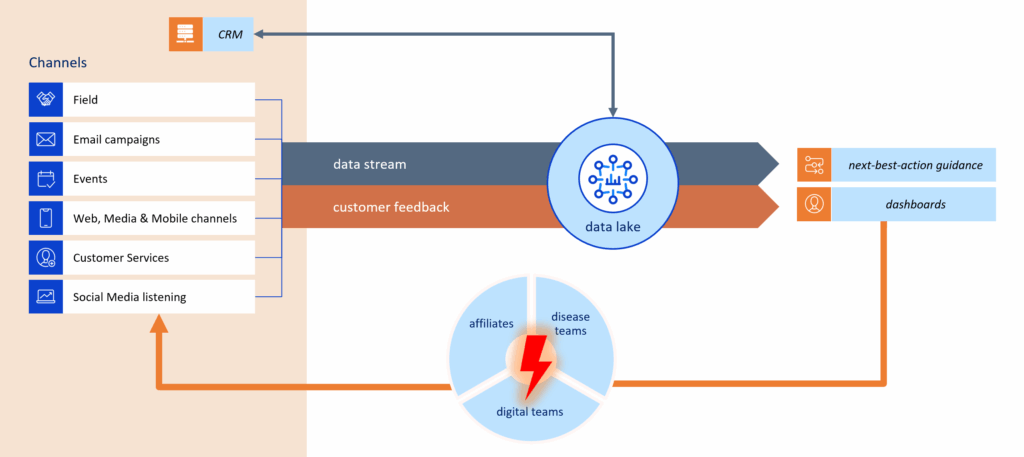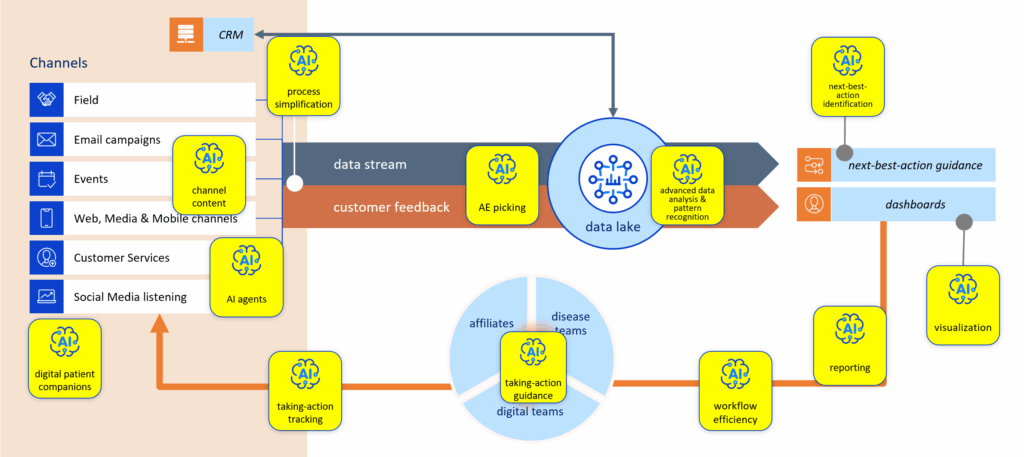The digital transformation imperative in pharma
The pharmaceutical, medtech, digital health and other life sciences industries are undergoing a profound transformation. Traditional, one-directional ways of engaging customers (healthcare professionals and patients) are giving way to data-driven, omnichannel strategies. Patients, HCPs, and other stakeholders, like regulators, authorities and payers, expect seamless, personalized, and timely interactions; whether through face-to-face meetings, digital channels, or hybrid approaches.
Why AI is a game-changer for digital customer engagement?
In 2025, Artificial Intelligence (AI) is no longer a futuristic concept – it is an operational necessity. From streamlining internal processes to delivering personalized content at scale, AI empowers companies to move from reactive engagement to proactive, insight-driven strategies.
Let’s put it into context of a closed-loop omnichannel ecosystem, a cycle where every customer interaction generates data, feeds into central systems, produces insights, and informs tactial next actions as well as strategy adjustments. When powered by AI, this loop not only elevates effectiveness but also increases efficiency, leading to meaningful engagement and stronger outcomes for patients and providers alike.
Let’s have a quick look at what I am talking about when refererring to a “closed-loop omnichannel ecosystem”.
or jump directly to the Practical Guidance for Pharma Leaders
Understanding the Closed-Loop Omnichannel Ecosystem
A closed-loop omnichannel ecosystem connects four critical stages:
- Channel Management – Delivering messages and services through multiple (mostly) digital and (in pharma still) physical touchpoints.
- Channel & Feedback Data Stream to internal Data Lakes – Systematically and real-time capturing data on channel performance, customer behavior, and feedback across channels.
- Analytics Dashboards & Visualization – Turning data into insights for decision-makers.
- Taking Action – Enabling product and digital teams to learn and execute improvements to channels & content, refine campaigns & strategies, or take direct action where required, e.g. on customer feedback.
This loop is continuous: every engagement informs the next. Success depends on constant learning, feedback integration, and adaptation – all areas where AI can amplify value.

AI Along the Closed-Loop Omnichannel Ecosystem

Step 1: Channel Management
AI Solutions:
- Personalization engines: Tailor content and timing for HCPs and patients.
- Content recommendation systems: Suggest relevant materials across email, websites, and portals.
- NLP chatbots/virtual assistants: Provide on-demand support, medical information, or guidance. E.g. digital patient companions.
Pros
- Scales personalized engagement beyond human capacity.
- Improves customer happyiness with relevant, timely touchpoints.
- Optimizes content impact and a seamless and satisfying customer experience across channels.
- Opens opprtunities for new patient support tools and channels.
- Long-term opportunity to have a fully connected AI agentic framework in place.
Cons
- Risk of “over-automation” leading to impersonal experiences.
- Requires well-structured, need-based, high-quality content libraries to fuel personalization.
- Regulatory oversight on claims and messaging might add complexity if approached the wrong way.
- False assumption that “AI does the job”.
Step 2: Channel & Customer Feedback Data Stream to internal Data Lakes
AI Solutions:
- Natural Language Processing (NLP): Extract insights from emails, call notes, survey responses, etc..
- Data harmonization models: Standardize information across channels and systems.
- Automated tagging/classification: Organize content and interactions into structured formats. E.g. automatied first-line detection of potential Adverse Events being mentioned in feedback data.
Pros
- Unlocks insights from unstructured data (often 70–80% of pharma feedback).
- Enhances data accuracy, reducing manual cleaning.
- Enables real-time monitoring of customer sentiment and needs … as well as taking action on it.
- Dramatically reduces load for manual analysis of data.
Cons
- Sensitive data requires strict governance and compliance controls. E.g. AI-provided AE detection requires zero tolerance for false negatives.
- Models need continual tuning for domain-specific terminology.
- Data lakes can become “data swamps” if not curated properly.
Step 3: Business Analytics Dashboards & Visualization
AI Solutions:
- Predictive analytics: Forecast engagement trends, channel & content performance, and HCP and patients needs.
- Anomaly detection: Identify unusual customer behavior or channel malfunctions patterns early.
- Automated reporting: Generate dashboards with minimal human effort.
- Customer segmentation models: Group HCPs or patients by behavior, need, or potential.
Pros
- Improves decision-making speed and accuracy.
- Makes complex data accessible to non-technical teams.
- Helps identify “next best action” opportunities.
Cons
- Data analysis needs clearly defined requirements on the “what for” and which focused guidance provided of specific end users (e.g. product teams, digital channel owners, management) to avoid useless dashboards which are spammed with unfocused data not adding any value.
- Over-reliance on dashboards can create “analysis paralysis”.
- Predictions are only as good as the data quality. There is a risk of bias if models are trained on incomplete datasets or users are overinterpreting early data.
Step 4: Taking Action (Product & Digital Teams)
AI Solutions:
- Decision-support systems: Suggest next best actions for field or digital marketing.
- Campaign optimization models: Adjust campaigns in real time based on performance.
- Scenario simulation engines: Test “what if” strategies before implementation.
Pros
- Empowers teams with evidence-based recommendations.
- Optimizes resource allocation and ROI of campaigns.
- Enables agility – fast pivoting based on performance data.
Cons
- May be resisted by teams wary of “AI telling them what to do.”
- Requires trust in model transparency and explainability.
- Over-optimization risks losing human judgment and creativity.
Practical Guidance for Pharma Leaders
Where to start (quick wins vs. strategic initiatives)
- Quick wins: Advanced data analytics & pattern recognition, NLP for feedback analysis, autmated reporting, and workflow simplifications & efficiencies.
- Strategic initiatives to be prioritized: Predictive analytics, integrated decision-support, personalization engines.
Prioritization framework
- Foundations first: E.g. have a corporate impact metrics system in place, combining business, CX and channel KPIs.
- Efficiency: Reduce manual workload with automation.
- Effectiveness: Improve engagement impact through taking action on feedback and channel usage data.
- Compliance: Ensure data security, traceability, and regulatory alignment.
- Patient value: Get guidance for smarter investments with better patient outcomes and business results.
Common pitfalls to avoid
- Not having relevant & specific impact metrics in place. Or not having channel, CX and business metrics well connected.
- Falling in love with “oustanding” standalone solutions without considering the integrated ecosystem.
- Being focused on fancy technology without clarity on how defined and prioritized business outcomes are supported.
- Starting with too many pilots that never scale … and lack of a plan how to upscale factually successful pilots.
- Underestimating the need for high-quality, clean, harmonized data.
- Missing the opportunity to take action on customer feedback and closed-loop learnings. Knowing is not enough – the power is with applying.
Building AI-ready processes and culture
- Foster cross-functional teams (digital, commercial, medical, IT, insights, CX, compliance, …), physically sitting together at one table and working hand in hand towards the same outcomes.
- Promote a culture of experimentation and looped learning, based on clearly defined and agreed outcomes. AI analysed and optimized data and feedback will provide guidance.
- Ensure governance structures being in place which provide clarity on roles and balance innovation with responsibility.
Conclusion
The inspiring outlook: AI as an enabler of smarter, more human engagement
When thoughtfully integrated, AI doesn’t replace the human touch in pharma – it enhances it. By automating the repetitive, surfacing insights, and guiding next best actions, AI allows teams to focus on what matters most: building trust and delivering value to patients and healthcare providers.
Call to action: shaping the future of customer experience
The closed-loop omnichannel ecosystem, powered by AI, is not a distant vision. It is happening now. Business and IT leaders who act today will shape the future of customer engagement in pharma and life sciences. The opportunity is clear: harness AI to create not just efficient systems, but meaningful, lasting connections that drive better health outcomes worldwide.
